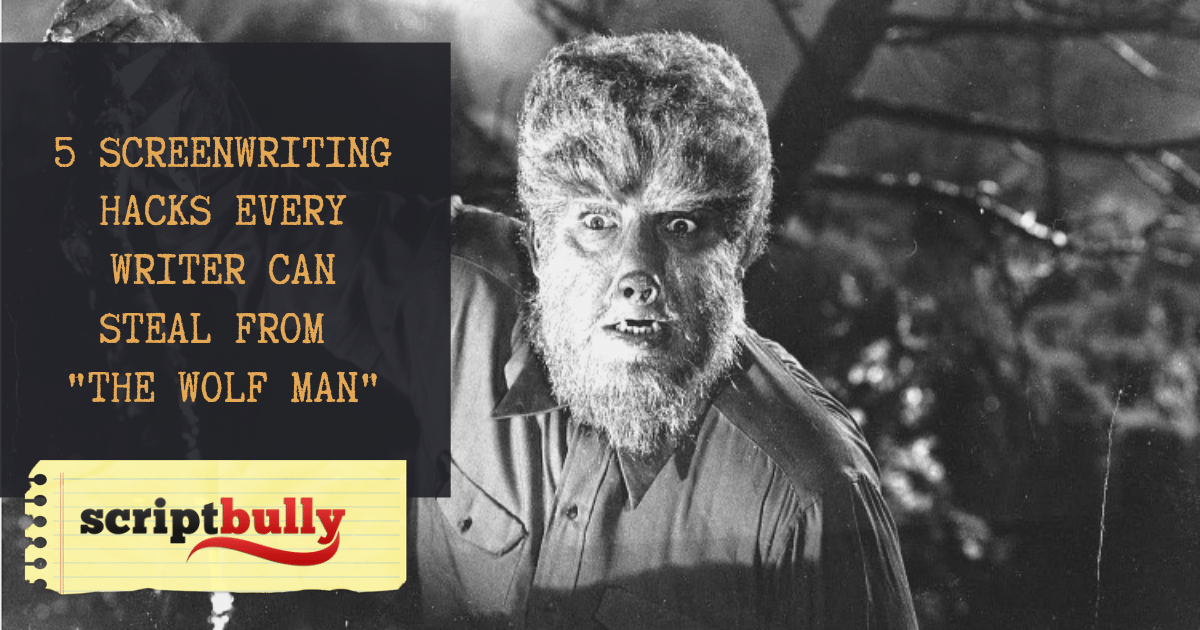The Wolf Man from 1941 represents not only Universal Studios at the height of its classic horror period, but its a film that literally “wrote the book” on werewolf lore. (There ain’t no “silver bullets” and “full moon” wolf-y stuff without this movie.)
And though The Wolf Man may seem a bit implausible during a modern viewing — do any of us really believe 5’6 English Claude Rains is the father of 6’3 American Lon Chaney Jr.? — the film does offer a case study in how screenwriter Curt Siodmak not only built a vibrant story world…
…but also helped exorcise some of his personal demons. (In the service of a ripping classic horror yarn.)
So, sit back, relax (but don’t get too relaxed) and enjoy these 5 things every would-be horror screenwriter can learn from the classic movie “The Wolf Man.”
Key Takeaways (Or For Those Who Have ADD):
- Use personal horrors as inspiration for your horror tale
- Create your own scientific backstory (the Masters did it)
- Pay attention and steal, steal, steal
- Make your climax intimate and emotional
- Don’t explain theme, just use powerful visual symbols
Horror Screenwriting Hack #1: All Good Horror Movies Start With “Personal” Horror
The Wolf Man these days may seem like a run-of-the-mill horror flick, in which the main character gets to embrace his inner cocker-spaniel, but the inspiration for screenwriter Curt Siodmak was far more personal.
The holocaust.
Siodmak had fled the persecution of the Jews in Dresden, Germany and found himself drawn to writing a Greek tragedy, “disguised” as a horror film.
A story in which the gods have cursed the “hero” of a story. And this “hero” may appear to be a monster, but he is simply the victim of a curse. An outsider on the fringes of society who is hated, pursued, hunted — and eventually killed — by a mob who don’t learn until too late that he is one of them.
And the one plot device that Siodmak fought for the hardest was the “mark of the pentagram” that each victim of the wolf carries with them to designate their dim prospects for the future. It was this plot detail that Siodmak felt most resonated with his own experience as a Jew, labeled in war-time. (And transformed his “little horror picture” into something far more powerful and lasting.)
And the one plot device that Siodmak fought for the hardest was the “mark of the pentagram” that each victim of the wolf carries with them to designate their dim prospects for the future. It was this plot detail that Siodmak felt most resonated with his own experience as a Jew, labeled in war-time.
Action Step: If yer writing a horror picture, start off with your own personal horror. (And then find a dramatic, visual way to express that horror.)
Horror Screenwriting Hack #2: When in Doubt, Create Your OWN History
Much of the exposition in the “Wolf Man” goes to great lengths to establish that lycanthropy — the affliction of being a big, bad wolf-y — has its origins in the ancient world.
With legend having it that the victim, after being bitten, becomes full-on werewolf during a full moon. And that the only way to kill a werewolf is with silver.
And it sounds very plausible. And old-time, Gypsy legend-y.
Only, it’s total B.S.
Siodmak made it all up. The only “legend” of lycanthropy had to do with a person unwittingly eating a wolf’s brain. (Fat chance, that.)
Siodmak is the one who made the brilliant creative decision to make “werewolf transmission” much more intimate, through a bite. And by tying the wolf’s ascendance to the moon he came up with a kick-ass way to build a time lock, that boosts tension without revealing the transformation too early.
Siodmak is the one who made the brilliant creative decision to make “werewolf transmission” much more intimate, through a bite.
Action Step: Feel your story lacks urgency or stakes? Simply give it a historical basis – that you, of course, make up – and use your newfound legend and lore to boost your story’s potential.
Horror Screenwriting Hack #3: Your Story Solutions Can Come From Anywhere
Though the initial spark for the story came from Siodmak’s traumatic experience as a Jew in Third Reich Germany, many of the film’s other crucial elements came from a more mundane, everyday genesis.
Take the role of “silver.”
Siodmak needed an “Achilles Heel” for his wolf man. Something, that though uncommon, would prove to be his undoing.
And so, one day Siodmak was listening to “The Lone Ranger” on radio. And when he heard that good, old “Hi-Ho, Silver!” — Siodmak knew he had the ultimate werewolf equalizer. Silver. (Little did he know that he would be creating pillars of werewolf mythology for more than a half-century.)
Action Step: While you’re in the midst of writing a script – and banging your head against the wall trying to find a story solution – be open to finding that storytelling resolution in the most unlikely of places.
Horror Screenwriting Hack #4: Make Your Climax as Emotional (and Intimate) as Possible
Spoiler alert: I’m about to reveal the ending to a movie that was released in 1954. (Letting all you “Twitter trolls” get ready.)
In case it’s been awhile since you’ve seen “The Wolf Man,” the film ends with a climactic showdown in which wolf-infused Lon Chaney Jr. attacks the woman his “human self” is in love with. (Played by Evelyn Ankers.)
She is saved by the wolf-dude’s father, played with grace and charm by Claude Rains, who happens upon his “wolf son” and beats him with his “silver cane” — but not before Chaney Jr. takes out Dad…
…and the villagers arrive (a little late to the party) to find Chaney Jr. turning back into a human, right before he dies.
Talk about an uplifting ending! (I’m sure if Michael Bay had directed it there would have been a female lycanthropy scientist wearing a mini-skirt.)
Still, what’s most interesting about that ending is what Siodmak originally wrote. (Namely having Mr. Wolf Man kill a random villager and then having his father shoot him with a revolver that contained a silver bullet, which did not kill him.)
But Siodmak made TWO KEY CHANGES:
1) He had the SON kill the FATHER (Nice Freudian homage there)
2) He had the WOLF killed much more INTIMATELY (Up close with a cane, not from a distance with a pistol)
Siodmak felt the ending needed to be more visceral. More immediate. More grueling for the characters. (And the audience.)
And what could be more grueling than having a father have to kill his son in hand-to-hand combat? (And then to have that son turn his Dad into wolf meat.)
And in a majority of the scripts I read I find MOST — if not ALL — of them can always be more personal. More intimate. More in-your-face.
And in a majority of the scripts I read I find MOST – if not ALL – of them can always be more personal. More intimate. More in-your-face.
Don’t worry the studio will always make it “less” personal.
Action Step: As you write the ending to your screenplay, think of ways you can go farther, deeper, and more gut-wrenching than you think you can. (You might just find the perfect ending that way.)
Horror Screenwriting Hack #5: Let the Audience Find Their Own Symbolism
The fascinating thing about stories, and the horror genre especially, is how audiences will often project their own anxieties, concerns, and interpretations onto the yarn — independent of what the screenwriter intended.
Take the role of silver. Again.
More than a dozen Ph.D dissertations have been written about the role of silver in werewolf mythology. Some claim it’s a symbol of hard currency literally “killing” the middle class — an expression of the wealthy upper classes using the one weapon at their disposal to take out the afflicted bourgeoisie.
A more popular theory is that silver represents the Catholic church. (Most church-mandated tools are silver.) And perhaps the thinking goes that The Wolf Man is a parable about the church’s role in eliminating evil. (If a bit too late to help anybody in the graveyard that fateful night.)
Perhaps the most interesting symbolic takeaway from The Wolf Man may have been from the countless teenage boys who went to see the movie again and again. (The Wolf Man was the most successful of the Universal Horror films.)
I don’t think it’s a stretch to suggest that the werewolf — with his uncontrollable changes and appetite — resonates with an audience in the throes of puberty. (And drive-in movies.)
And though Siodmak never intended a religious or pre-pubescent reading of his film — he was after all going for Greek tragedy — it’s a legacy he would have certainly appreciated.
Action Step: Don’t explain your symbolism. Just use concrete imagery — and let the Ph.Ds figure it out.






